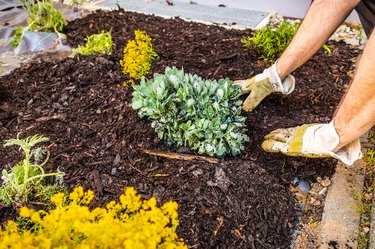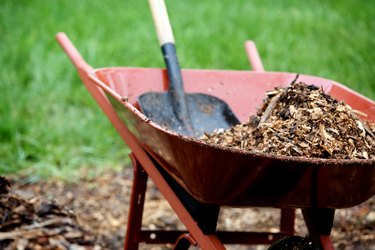
Mulching is layering organic or inorganic material around plants or over grass and weeds. It is both decorative and beneficial to plants and soil. While a mulch layer can be placed directly over unwanted grass or weeds, it is not the most effective method of killing existing weeds or controlling new ones. There are several additional techniques in addition to laying the mulch.
Eradicate Weeds With Solarization
Video of the Day
To prevent weeds from emerging through the mulch, a premulching technique is recommended. This is as simple as applying an herbicide to the area that will be mulched.
Video of the Day
For complete eradication of weeds, solarization is a better choice. This process entails laying clear plastic over the area to be mulched and then securing it with stakes or something heavy on the corners, completely limiting airflow. The plastic layer then traps solar radiation and raises the temperature underneath, killing established plants and thwarting any new seedlings attempting to emerge. When the plastic is removed, within four to six weeks, all plants in the affected area should be dead.
Consider the Depth of the Mulch
To completely block out sunlight and prohibit weed growth or regrowth, consider how deep the mulch should be laid. Fine-textured mulches, such as compost or sawdust, effectively block out sunlight with 2 to 3 inches of depth. However, coarser mulches with more gaps between pieces, such as wood nuggets or bark, require more depth to be effective, usually 4 to 6 inches.

Try Sheet Mulching
This technique provides several benefits. While killing weeds and prohibiting new growth, sheet mulching layers break down to feed the ground, creating a richer soil.
While a layer of landscaping fabric assists in stopping weeds, it is not foolproof. Many weeds break through the fibrous cloth. Another method is using newspaper sheets, which break down in time, benefiting the soil.
Spread out opened newspaper sheets in an overlapping pattern using at least 10 sheets per layer on the area to be mulched. Spray the newspapers with a hose to wet them thoroughly and then spread mulch over the top of the wet newspapers.
Tip
Choose a nonwindy day for sheet mulching with newspaper.
Post-Mulch Weed Control
While some methods work better than others, weeds and grass still appear at times and need to be hand-pulled or hoed. Postemergent commercial herbicides can be used. For those who prefer organic methods, spraying young plants with rubbing alcohol, undiluted vinegar, or a mix of the two and dishwashing liquid is also effective.